Fire and Rescue Service Wildfire Operational Guidance
This guidance has been produced to give fire and rescue service personnel an additional understanding and awareness of the phenomenon of wildfire. It examines the hazards, risks and controls relating to Fire and Rescue Service personnel, the personnel of other agencies and members of the public at Incidents of wildfire. It also provides a point of reference for those who may be called upon to plan for wildfire events and for those incident commanders and personnel responding to such incidents.
8B10 Safety at a Wildfire Incident
Introduction
8B10.01 Wildfires, as with any other type of fire, are potentially hazardous regardless of their size and intensity, and the risks to personnel are not limited to those posed exclusively by the fire.
8B10.02 This chapter is not intended to be seen, or used, as a definitive reference to all of the potential risk permutations associated with a wildfire incident. Rather, it should be utilised as a generic guide to the main risks which will be encountered at a wildfire event, and should form the basis of a more detailed risk assessment process based on the local circumstances within individual FRSs.
The Risk Assessment Process, FRSs should be well placed to identify the wide range of service-related and community risks and hazards associated with wildfire events in their areas, and enable the development of appropriate control measures and mitigation actions.
Fire Behaviour
8B10.04 Changes to wildfire fire behaviour can result in the following:
- An increase in intensity, normally resulting in a surge in flame growth.
- A rapid increase in the rate of travel through the horizontal fuel arrangement.
- A rapid change in direction and fire spread.
8B10.05 It is important to recognise that under certain situations all three changes can occur at the same time, or one change can be the precursor which triggers one, or both, of the others to take place.
8B10.06 As described in Part B6, the Wildfire Prediction System (WPS), the LACES Protocol and the maintenance of personal Situational Awareness during a wildfire incident, can all be used to alleviate risk. The main threat to firefighter safety at a wildfire incident is likely to be when a fire unexpectedly changes its behaviour. Personnel must remain constantly vigilant, and the operational situation must be subject to continual dynamic risk assessment by personnel who are trained in the understanding and awareness of wildfire behaviour. If potential fire change is identified then this should trigger a re-assessment and adjustment of the fire plan and to the tactics being used.
8B10.07 Monitoring changes to the main wildfire influences of fuel, weather and topography will not only allow FRS personnel to develop an appreciation of where, and potentially when, fire behaviour will change, it will also identify areas of highest risk where the placement of personnel and equipment should be avoided.
Common Situations that bring about Changes to Fire Behaviour
8B10.08 While much of the following section has been addressed in more detail in preceding sections, it is considered beneficial to briefly summarise the factors most likely to influence a change in the behaviour of the wildfire.
(a) Changes to Fuel
8B10.09 The size of the available fuel and the way in which it is arranged play a fundamental part in fire development. Dry fine fuels that are supportive to fire and arranged in continuity will readily support fire spread. When fire has access to an abundance of finer fuels, fire spread and intensities can become extremely intense. This is particularly relevant when fine fuels exist in both the horizontal and vertical arrangements, as this can allow the fire to penetrate into, and consume, the aerial fuels which can exist in huge quantities, resulting in a dangerous and rapid growth in fire intensity. This in itself can generate a further increase in the combustion process and accelerate the rate of fire growth. Another consideration should be the quantity of dead fuels that are available, not only at surface level but also in the elevated and aerial fuels.
(b) Changes to Fuel Moisture
8B10.10 Moisture found on, or contained within, fuel will determine how supportive it will be to the combustion process. Fine fuels dry out much more quickly than coarse fuels and this can lead to a rapid increase in fire intensity. Relative humidity readings can be used to indicate how dry fuels are and, when this is low, fine fuels will generally burn with considerable intensity. Dead fine fuels are particularly responsive to changes in the atmosphere and, when present, can be extremely supportive to the combustion process.
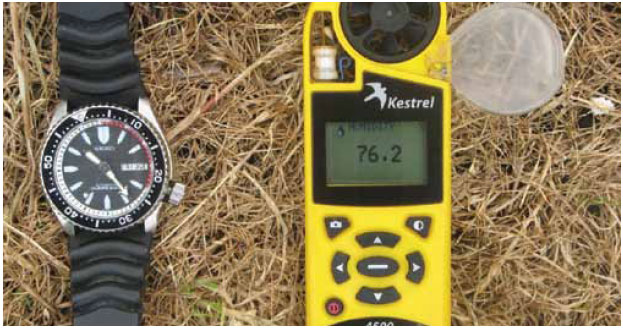
Photo B10.1
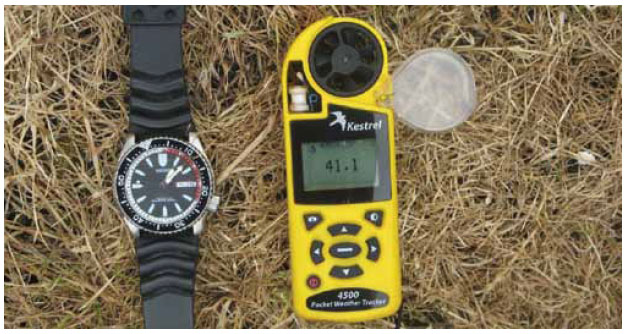
Photo B10.2
Photos B10.1 and B10.2 show the reduction of the moisture content within the atmosphere over a relatively short period of time. Rapid reductions in relative humidity allow the fuel to dry quickly, become more susceptible to combustion, and escalates the intensity of the fire. Depending upon the weather conditions, the drop in relative humidity can occur over an even shorter period of time.
8B10.11 A prolonged drying environment can have a significant impact on fire behaviour. A period of drought can dry out the ground, meaning that there is no resistance to fire development as the fire expends no energy overcoming the moisture content contained within the ground or surface fuels.
(c) The Temperature of Fuels
8B10.12 Fuels arranged across the landscape will be heated to different temperatures, those that are exposed to solar heating will generally be warmer (and dryer) than those that are not. Those fuels that are subject to prolonged exposure will normally be the warmest. The temperature of fuel affects the amount of heat it will take to ignite it, therefore fuels that are already warm will ignite and support flame propagation more readily than cooler ones.
8B10.13 Surface fuels that exist below aerial fuels can often be shaded and therefore cooler. Should the arrangement support vertical fire development there may be a rapid change in fire behaviour as the fire spreads into the hotter fuels above.
(d) Aerial Fuels
8B10.14 This effect can also influence vertical and horizontal fire spread above an existing fire. For example if a surface fire is burning under a dense canopy it is likely that the aerial fuels are subject to more sunlight than the shaded surface fuels. This may result in the aerial fuels being significantly warmer and dryer. If the fire penetrates into these fuels these may more readily support the combustion process resulting in the possibility of rapid and significant change to fire intensity, rate of spread and sometimes direction.
(e) Spotting
8B10.15 Both short and long-range spotting can be extremely dangerous. Shorter-range spotting can cause a fire to increase in intensity and accelerate fire development. Longer-range spotting can ignite fuels considerable distances away from the main fire, and depending on the fuels and fire alignments these occur in, may result in fires that demonstrate very different fire behaviour to the original wildfire. Spotting can also compromise escape routes and can penetrate into fuels beyond control lines.
(f) Upslope
8B10.16 An increase in the angle of a slope will result in an increase in rate of spread and fire intensity. Upslopes are particularly dangerous, and it is important that firefighters are not positioned above a fire on a slope.
(g) Downslope Hazards
8B10.17 If a fire is backing down a slope and firefighters are positioned below the fire on the slope and in unburnt fuel, there is the possibility that rolling materials or spotting could ignite secondary fires behind and below the firefighter's position. This is a particularly dangerous situation as the secondary fires may be much more intense, burning upslope with the support of the wind.
(h) Slope Reversal
8B10.18 When a fire is burning downslope, and then moves into a position where it has the opportunity to burn upslope, there is a possibility of a rapid if not immediate increase in fire intensity and rate of spread.
(i) Aspect
8B10.19 The direction a slope faces in relation to the sun affects the type, temperature and dryness of fuel. This can have a dramatic effect on fire intensity and rate of fire spread.
(j) Shape of the Landscape
8B10.20 The shape of the landscape can influence wind direction and strength. Certain features such steep-sided valleys or gullies can funnel and concentrate wind significantly which may result in a corresponding change to fire behaviour and a rapid acceleration in fire spread.
(k) Wind
8B10.21 Wind is a primary factor to consider as changes to its strength or direction can result in a fire quickly increasing in intensity and/or rate of spread. Changes to wind direction do not necessarily have to be extreme, a subtle change can enlarge the width of a head fire which can result in a seemingly disproportionate change in fire behaviour.
(l) Atmospheric Stability
8B10.22 A stable atmosphere normally restricts fire development limiting fire intensities and rate of spread. An atmosphere that is unstable can create a fire environment that can become progressively more erratic and less predictable. A rapid change from a stable to an unstable atmosphere can have a sudden and dangerous impact on a fire.
(m) Changes to More than One Factor
8B10.23 Particularly hazardous situations may arise if more than one factor combines causing a cumulative effect. This can result in an almost immediate and dramatic increase in fire development.
The Importance of the Key Factors
8B10.24 The key factors can be used to assess whether extreme fire activity is likely to occur. The presence of a single indicator may lead to a dangerous increase in fire intensity or spread, but when the fire environment is influenced by a combination of these factors the situation can become increasingly serious.
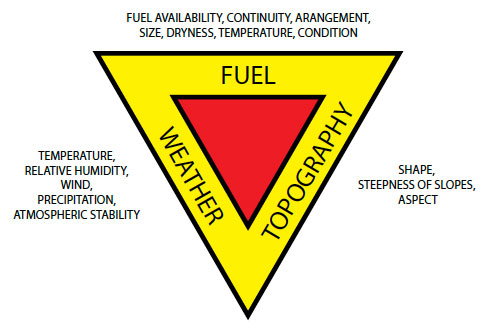
Fig. B10.1 Showing how, fuel, topography and weather interact and influence fire behaviour
Working in the Outdoor Environment
Heat-related Illnesses
8B10.25 During a wildfire event it is important to be aware of the added physical demands that are placed on the body and to be able to recognise the signs and symptoms of a heat-related illness. There are different types of heat-related illnesses, ranging from those that cause temporary discomfort, to the much more dangerous, and potentially fatal, condition of heat stroke. In a wildfire environment the symptoms of a heat-related illness may appear due to the combined effects of exposure to extreme temperatures (whether environmental or from the wildfire itself), arduous working conditions, unsuitable PPE and lack of regular fluid intake.
The following checklist can help you recognise the symptoms of heat-related illnesses:
Heat Rash
8B10.26 Personnel may suffer from skin irritation caused by excessive sweating brought about by firefighting conditions and prolonged exposure to high temperatures.
Heat Cramps
8B10.27 Fire Service personnel who have been participating in strenuous activity in the heat may develop muscle spasms in the arms, legs, or abdomen. These can be painful and debilitating. The individual's body temperature is usually normal, and the skin will feel moist and cool, but sweaty.
Heat Syncope
8B10.28 Personnel may experience the sudden onset of dizziness or fainting after exposure to high temperatures. Personnel undertaking firefighting operations in high ambient temperatures or at the fire front will be at greatest risk. As with heat cramps, the physical indicators of the onset of heat syncope may be pale, sweaty skin which remains cool, a weakened pulse and a heart rate that is usually rapid.
Heat Exhaustion
8B10.29 Should alert personnel to a deteriorating situation and is a warning that the body is beginning to overheat. A person with heat exhaustion may be thirsty, sweating profusely, lightheaded, weak, unco-ordinated. In more advanced cases personnel may become nauseous. Other symptoms may resemble those of heat syncope and heat cramps.
Heatstroke
8B10.30 Heatstroke is a very serious, and potentially fatal, condition that occurs when the body loses its ability to control its temperature. Once an individual is suffering from heatstroke critical medical intervention is absolutely essential. Immediate first aid cooling of the body should begin at once. Personnel suffering from heatstroke will normally develop a fever that rapidly rises to dangerous levels within minutes. Body temperature may rise above 104º F (40ºC). Other symptoms and signs of heatstroke may include confusion, agitation, hallucinations, feeling faint, loss of balance, strong rapid pulse, dry flushed skin, and a lack of sweating. Coma can also result from heatstroke.
Travelling on Foot
8B10.31 FRSs must assess the risks of deploying personnel and resources into forested, muirland (moorland), heath and remote rural landscapes. If personnel have to leave recognised roads and paths they should be provided with appropriate training to enable safe navigation.
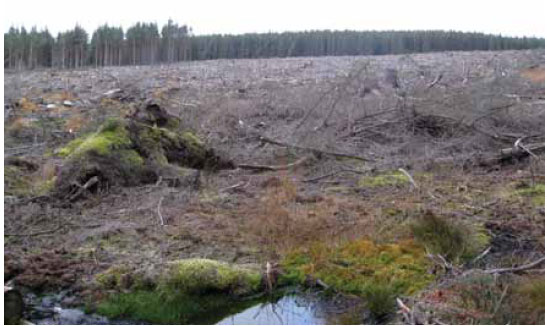
Photo B10.3 An area of slash following block harvesting showing the difficult terrain that personnel may need to traverse
When travelling on foot the following should be considered:
- The essential elements of LACES should be put in place before deployment.
- The team should be led by a supervisor who has wildfire and map reading/navigation competencies.
- Teams should be equipped with a radio, a map of the area and a compass.
- Follow a planned route that avoids steep inclines or declines wherever possible.
- Consider the types and arrangement of fuels that are on the landscape.
- Consider the direction and rate of fire spread and any change that might occur.
- All team members should carry sufficient water and food to provide sustenance for at least 4 hours.
- Travel at a speed that is appropriate to the distance to be covered and the fitness levels within the team.
- The team must remain in communication with each other.
- To avoid injury from vegetation (springing branches) or hand tools being carried by other team members, personnel should remain at least 2 metres apart.
- If working at night or in low light conditions, each team member must carry appropriate lighting equipment.
- Appropriate footwear for the conditions should be worn. It is recommended that boots which provide good ankle support are worn.
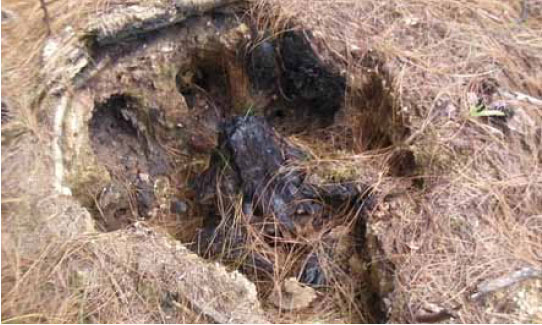
Photo B10.4 A stump hole which presents an obvious injury risk to firefighters - both as a trip hazard and due to the potential for the hole to be full of hot embers. Stump holes can be very difficult to see when full of ash and debris.
The Use of Topographical Maps
8B10.32 At large spatial incidents, the ability to read and understand topographical maps is critical to control and manage safety. Personnel within the command team and on the fire ground must have an appropriate understanding of topographical maps and the navigation skills appropriate to their role. Measures must be taken to ensure that personnel on the fire ground have, or have access to, topographical maps that are relevant to their location and task.
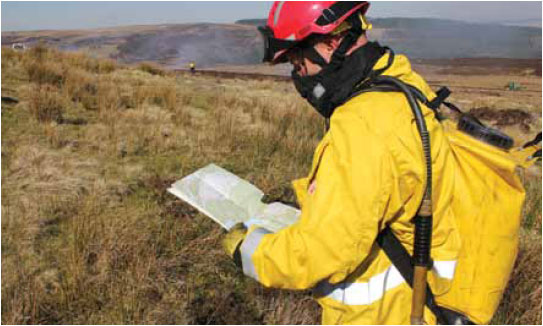
Photo B10.5 A trained firefighter using an OS map to identify features on the landscape
Night-time Firefighting
8B10.33 As night-time hours provide cooler temperatures, higher fuel moisture and higher relative humidity levels, there is an opportunity to firefight in conditions which have the potential to offer a substantial reduction in fire intensity.
8B10.34 Despite the potential benefits that may arise from conducting properly risk-assessed operations during darkness, there are a number of risks that will increase - the most obvious being slips and trips.
Increased risks to personnel during night-time operations will arise from:
- Reduced visibility.
- Concealment of other fireground hazards, e.g. potholes, tree-stumps, power lines.
- Greater potential for the isolation of personnel.
- Colder, and generally more difficult, working conditions.
8B10.35 There are a number of ways which FRSs may wish to consider mitigating the potential for increased risks to personnel if night-time working is considered appropriate or necessary:
- No lone working.
- Using substantially fewer people.
- Limiting night-time operations to the completion of specific tasks identified within the tactical incident plan that will have a significant impact on the fire or its future development.
- Wherever possible, crews being led by personnel that have had advanced or specialist training.
- Ensuring crews deployed at night time are suitably equipped in accordance with local procedures.
- Operations being carried out close to recognised roads or tracks whenever possible.
The Use of Tools
Hand Tools
8B10.36 This guidance has described a number of suppression methods that require the use of hand tools. Generally, hand tools are used to clear vegetation for ease of access/movement and for the construction of control lines. Some of the equipment that is commonly used within the wildfire arena will be unfamiliar to many firefighters.
8B10.37 As with any hand tool, incorrect or careless handling can result in injury, so it is recommended that FRSs raise awareness among their personnel as to the safe operation of these tools.
Basic Rules
- Tools should be well maintained, tested and ready for use.
- Hand tools should comply with the appropriate and relevant standards of manufacture.
- Many of the tools have sharp edges and, when not in use, a guard should be fitted.
- When being carried, tools should be carried at the side positioned at their balance point and with the working part pointing forward so that the dangerous part of the tool is in full view.
- Tools should never be carried on the shoulder.
- Never use a damaged or defective hand tool.
- Hand tools are particularly dangerous when they are being used, a safe working distance between operatives must be maintained and should normally be at least 3 metres.
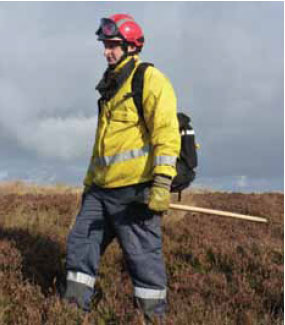
Photo B10.6 Showing a firefighter correctly carrying a polaski
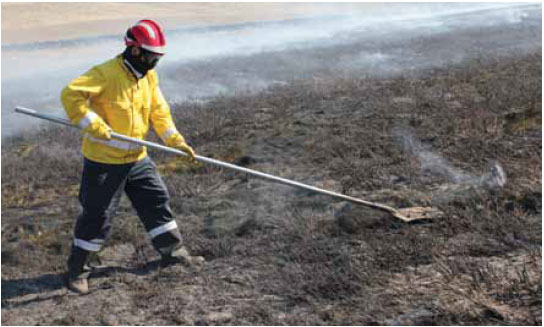
Photo B10.7 Firefighter using a long handled metal scraper
Powered Hand Tools
8B10.38 Portable powered hand tools can be used to reduce the time and effort required to complete a task such as control line construction.
8B10.39 It is imperative that appropriate training is provided to all FRS personnel who may be required to operate powered hand tools, such as chain saws, brush cutters and strimmers, within a wildfire environment.
8B10.40 FRSs will be able to provide appropriate initial and maintenance training, but may find operational opportunities limited for personnel to gain and develop additional experience to further develop their expertise. Due to the specialist skills involved in the operation of powered hand tools and the maintenance of user accreditation, this guidance encourages an interagency approach whereby FRSs, whenever possible, also establish partnerships with agencies that already have available and qualified operatives.
8B10.41 Aside from reducing the risk to FRS personnel, the additional benefit of this approach is that tool operators from a land management background can also provide invaluable, experience, local knowledge and expertise to the Incident Commander.
8B10.42 When a mechanical tool is being operated, other personnel must keep a safe distance from the working area. The distance will depend upon the particular powered hand tool in use and FRS personnel should follow any instructions given by the tool operative.
Drip Torches
8B10.43 Drip torches are an item of equipment which many FRSs will be unfamiliar with. Due to the potential dangers involved in using drip torches, there are a number of safety feature built into their design. Torches are fitted with a check valve to control the flow of fuel through the igniter, as well as valves and safety features which prevent flame from traveling backwards up the nozzle and igniting the tank.
- Only trained specialists should use drip torches.
- Appropriate PPE should be worn at all times when operating and refilling drip torches.
- Drip torches should be well maintained and be subject to an appropriate testing system.
- Ensure that the correct fuel mix is used.
- Keep the drip torch away from your body, clothing, and boots.
- Always carry the drip torch upright with spout forward until ready for use.
- Only carry the drip torch by the handle.
- There should be clear guidance providing information on the methods of fuelling and refuelling.
- Drip torches should only be lit when in use and extinguished as soon as this work is completed.
- On the fire ground they should be stored in a safe place.
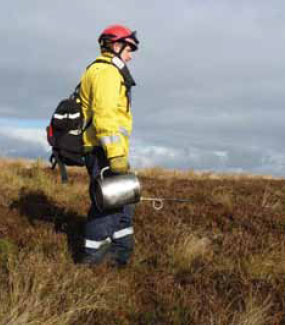
Photo B10.8 Correct handling of a large drip torch
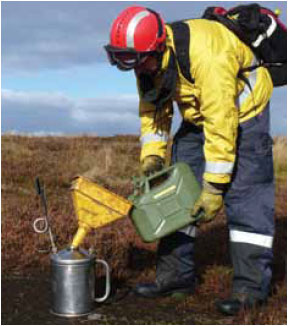
Photo B10.9 Correct re-filling of a drip torch - full PPE, away from ignition sources and preventing spillages
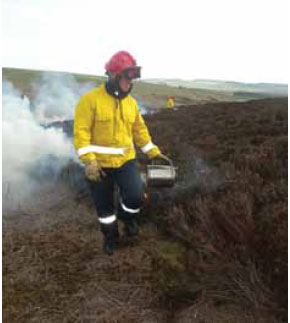
Photo B10.10 Showing a firefighter carefully using a drip torch to ignite vegetation
The Safe Use of Vehicles
8B10.44 It is imperative that personnel fully appreciate the limitations of FRS vehicles deployed to wildfire incidents and do not use them inappropriately. An understanding of the vehicles' limitations and off-road capability must be established, even those with a 4x4 or 'all terrain' capability. When operating 'off road', vehicles should only be driven by personnel who have received specific training.
8B10.45 It is recommended that a risk assessment is carried out to establish appropriate safe systems of work for all vehicles in operation within individual services if they have to be deployed off roadways or hard standing.
8B10.46 During the development of wildfire fire plans all relevant vehicle access and egress routes, pathways, tracks and hard standing which may be suitable for use by fire service vehicles should be identified and recorded.
8B10.47 When vehicles are deployed onto a wildfire fire ground, the LACES protocol still applies. The vehicle OiC should establish all of the elements contained within the protocol.
General Vehicle Safety
- Never get on or off vehicles when they are moving.
- Ensure that vehicles are checked before operation to ensure that they are fully fuelled, tyre pressures and water levels are satisfactory, and mirrors are properly adjusted and that all vehicles lights are in working order.
- When vehicles are parked on slopes ensure the handbrake is always applied; the vehicle is left in gear (or Park if automatic) and, where necessary, the wheels are chocked.
- Avoid traversing slopes if possible.
- Consider using headlights at all times to improve visibility to other vehicles and personnel.
- Depending upon the type of vehicle being used, whenever there is a need to drive off road it may be necessary to ensure that personnel are utilised to assess ground conditions ahead of the vehicle.
- Avoid parking under power lines.
- On undulating ground be aware of the risk of 'bottoming out'.
Vehicle Entrapment
8B10.48 Fire Service vehicles can be vulnerable to entrapment at wildfire incidents, and personnel should always be mindful to prevent situations developing where personnel are placed in danger of being unable to escape in the vehicle or they need to use the vehicle as a refuge.
8B10.49 To avoid entrapment, the following should be considered:
- Avoid parking vehicles in areas of vegetation or under tree canopies.
- If there is sufficient time, and trained personnel available, vegetation can be cleared or burned out to reduce fuel loading around vehicles.
- Maintain vigilance when vehicle pumps are being used to ensure that vehicles do not become bogged down in soft ground.
- Park vehicles behind natural barriers or structure for protection.
- Avoid taking vehicles into saddles and re-entrants.
- Always park vehicles in the direction of escape and ensure that the escape route has been recced to ensure it is suitable and obstruction free.
- Ensure any bridges can support the weight of the vehicle.
- Do not leave a vehicle parked unattended on a road or track as this as may block an escape route.
8B10.50 FRSs should work with partners to establish guidance controlling the use of vehicles and emergency action in the event of vehicle entrapment on the fire ground.
The Use of Machines
8B10.51 Machines should only be used once a thorough risk assessment has been carried out and specific control measures have been put in place. Operators should never be allowed to work alone and, where necessary, fire service support should be provided. If deployed onto the fire ground, vehicle drivers and machine operators must be incorporated into the LACES safety protocol.
8B10.52 Specific vehicles or machines such as tractors, excavators, harvesters, mulchers, etc. will almost always be provided by contractors or land management partners, Fire Service personnel must take cognisance of the safety information and guidance provided by the operators of the machinery involved.
8B10.53 Where appropriate, and as part of preparedness activities, FRS personnel should be made aware of the vehicles and equipment which may be deployed by partners at wildfire incidents. This should include any risks involved in their use and the safe systems of work to be adopted by both the operators and FRS personnel.
Personnel Safety
- FRSs must ensure that personnel are provided with Personal Protective Equipment (PPE) which is suitable and appropriate for attendance at a wildfire incident.
- When involved in firefighting activities PPE must be worn at all times. Dressing down should only be permitted during rest periods away from the fire, and only when completely safe to do so.
- Personnel operating on the fire ground should be fully briefed before deployment and fully understand their role.
- When deployed onto the fire ground, it is essential that personnel undertake a complete equipment inventory check before deployment.
- Essential personal equipment will depend on the wildfire circumstances and local procedures, but it is recommended that it should include, PPE, firefighting equipment, a map of the area, a hand-held radio and fluids.
- All personnel should be aware of, and operate under, the LACES protocol.
- Effective communications between individuals, crews and command support personnel should be maintained at all times.
- Due to the arduous working conditions associated with wildfire incidents, personnel should be aware of the signs and symptoms of heat-related illnesses such as heat cramps, heat stress, heat exhaustion and heat stroke.
- Arrangements should be made to ensure that personnel have access to water/fluids to prevent dehydration.
- Due to the arduous working conditions, regular reliefs should be considered.
- Personnel should, whenever possible, work upwind and behind the fire, thus avoiding heavy concentrations of heat and smoke.
- Smoke can impair vision preventing observation of the fire and its behaviour and obscure visual contact with other personnel.
- Always maintain good escape routes to a designated safety zone.
- When working in or around tree cover, personnel should always be aware of the stability of surrounding trees.
- Remain vigilant and maintain your situational awareness at all times.
- Do not become too focused on a task, observe what is happening around you; 'look up, down and around'.
- Whenever personnel are operating within the vicinity of aircraft (fixed-wing or rotary), then guidance and instruction must be taken from the aircraft crew, or the safety officer responsible for the landing and refuelling zone.
- Personnel should never operate any item of equipment that they are unfamiliar with.
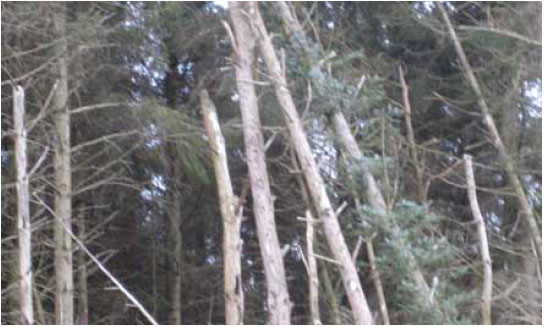
Photo B10.11 Showing unstable conifers being supported by neighbouring trees. In the event of a fire affecting the stability and integrity of the supporting trees, a collapse may occur without warning - hence the nickname 'widow makers'
8B10 Key Considerations
- LACES, WPS and the application of situational awareness can all be used to mitigate risk at a wildfire event.
- Personnel should understand the common situations which lead to changes in fire behaviour.
- Heat-related illness is a major risk when working in the outdoor environment - personnel should be aware of the signs and symptoms of heat cramps, syncope, exhaustion and stroke.
- FRSs should ensure they have undertaken a thorough risk assessment of their response and deployment to a wildfire incident.
- The ability to read, use and understand topographical maps is a key skill which relevant personnel should possess.
- There are advantages to fighting a wildfire during night-time periods. This should be balanced against the additional hazards and risks that may be encountered when considering whether to undertake night-time operations.
- Personnel operating on the fire ground should be aware of dangerous parts of the landscape.
- Remain in contact with other team members and your supervisor - Do Not Work Alone!!
- Be in a position where you can see the fire - this is particularly important if there is unburned fuel between you and the fire.
- When working below a fire on a slope look out for any rolling material that could start secondary fires below your position.
- Always maintain good escape routes to a safety zone. These may have to be changed as the fire moves across the landscape.
- Personnel must ensure that they carry all safety equipment relevant to the operational situation.
- Do not become too focused on a task, observe what is happening around you; 'look up, down and around'.
Contact
Email: Dean Cowper
There is a problem
Thanks for your feedback